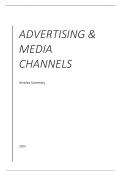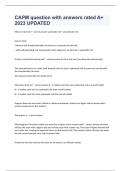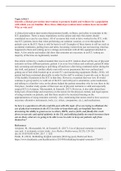ADVERTISING &
MEDIA
CHANNELS
Articles Summary
2024
,Table of Contents
Pritchard, M. (2021). Commentary: “Half my digital advertising is wasted…”. Journal of
Marketing, 85(1), 26-29. .................................................................................................................................... 2
Li, J., Abbasi, A., Cheema, A., & Abraham, L. B. (2020). Path to purpose? How online customer journeys
differ for hedonic versus utilitarian purchases. Journal of Marketing, 84(4), 127-146. ................................ 4
Danaher, P. J., Danaher, T. S., Smith, M. S., & Loaiza-Maya, R. (2020). Advertising effectiveness for
multiple retailer-brands in a multimedia and multichannel environment. Journal of Marketing
Research, 57(3), 445-467. .................................................................................................................................. 8
Vakratsas, D., & Ambler, T. (1999). How advertising works: what do we really know?. Journal of
marketing, 63(1), 26-43. .................................................................................................................................. 15
Srinivasan, S., Vanhuele, M., & Pauwels, K. (2010). Mind-set metrics in market response models: An
integrative approach. Journal of Marketing Research, 47(4), 672-684. ....................................................... 20
Valenti, A., Yildirim, G., Vanhuele, M., Srinivasan, S., & Pauwels, K. (2023). Advertising’s sequence of
effects on consumer mindset and sales: A comparison across brands and product categories. International
Journal of Research in Marketing .................................................................................................................. 23
Sethuraman, R., Tellis, G. J., & Briesch, R. A. (2011). How well does advertising work? Generalizations
from meta-analysis of brand advertising elasticities. Journal of Marketing Research, 48(3), 457-471. ...... 26
Dost, F., Phieler, U., Haenlein, M., & Libai, B. (2019). Seeding as part of the marketing mix: word-of-
mouth program interactions for fast-moving consumer goods. Journal of Marketing, 83(2), 62-81........... 32
Kim, H., & Hanssens, D. M. (2017). Advertising and word-of-mouth effects on pre-launch consumer
interest and initial sales of experience products. Journal of Interactive Marketing, 37(1), 57-74. .............. 35
Fischer, M. (2019). Practice prize paper–managing advertising campaigns for new product launches: an
application at mercedes-benz. Marketing Science, 38(2), 343-359. ............................................................... 37
Du, R. Y., Xu, L., & Wilbur, K. C. (2019). Immediate responses of online brand search and price search to
tv ads. Journal of Marketing, 83(4), 81-100. .................................................................................................. 41
Tirunillai, S., & Tellis, G. J. (2017). Does offline TV advertising affect online chatter? Quasi-experimental
analysis using synthetic control. Marketing Science, 36(6), 862-878............................................................ 43
Grewal, D., Bart, Y., Spann, M., & Zubcsek, P. P. (2016). Mobile advertising: A framework and research
agenda. Journal of interactive marketing, 34(1), 3-14. .................................................................................. 46
Bernritter, S. F., Ketelaar, P. E., & Sotgiu, F. (2021). Behaviorally targeted location-based mobile
marketing. Journal of the Academy of Marketing Science, 49(4), 677-702. ................................................. 50
Liadeli, G., Sotgiu, F., & Verlegh, P. W. (2023). A meta-analysis of the effects of brands’ owned social
media on social media engagement and sales. Journal of Marketing, 87(3), 406-427 ................................. 55
Dall’Olio, F., & Vakratsas, D. (2023). The impact of advertising creative strategy on advertising elasticity.
Journal of Marketing, 87(1), 26-44. ............................................................................................................... 58
Guitart, I. A., & Stremersch, S. (2020). The Impact of Informational and Emotional Television Ad Content
on Online Search and Sales ............................................................................................................................ 63
Eisend, M. (2009). A meta-analysis of humor in advertising. Journal of the Academy of Marketing Science,
37(2), 191-203 .................................................................................................................................................. 65
Rosengren, S., Eisend, M., Koslow, S., & Dahlen, M. (2020). A Meta-Analysis of When and How
Advertising Creativity Works. Journal of Marketing, 84(6), 39-56................................................................ 67
, Pritchard, M. (2021). Commentary: “Half my digital advertising is wasted…”. Journal
of Marketing, 85(1), 26-29.
In 1994, the first digital banner ad was launched, and the digital media revolution was born.
What followed has been an extraordinary transformation of ways to connect with, entertain,
inform, and engage consumers, with digital media disrupting every aspect of the advertising,
media, and marketing ecosystem. There have been many positive benefits from this revolution.
Creativity has expanded beyond the constraints of the 30-second TV ad, with new ways of
expressing brand benefits and points of view. Anything discoverable can now be found instantly
through search engines. Shopping for new products has never been easier or more frictionless
through ecommerce. And we can connect with people and engage the consumers we serve in
novel and entertaining ways we never thought possible.
But there has been a dark side to this revolution—most notably, massive inefficiencies resulting
in media waste, outright fraud, and issues of brand safety as documented in Gordon et al. (2021,
hereinafter Gordon et al.). More than a century ago, marketing pioneer John Wanamaker said,
“Half my advertising is wasted; the trouble is, I don’t know which half.” When the digital media
revolution began more than 25 years ago, marketers had high hopes that digital media would
solve the persistent problem of advertising waste that has plagued the industry since the advent
of mass marketing. With digital now the dominant form of media, substantial waste still exists,
but there are approaches for addressing inefficiencies. This commentary provides an overview
of the key problems facing marketers today and recommends possible solutions.
Viewability
Viewability means the opportunity to see an ad. Did the ad make it onto the screen where human
eyes can see it? Having a common standard for assessing digital ad viewability is important for
conducting business transparently and comparatively across platforms. However, for many
years, each platform created its own viewability metric, which was used to set payment terms
for advertising. P&G found that the average view time for digital ads was approximately 1.7
seconds, little more than a glance. We realized that we were spending far too much money on
static digital display ads, which consumers were skipping past with little to no engagement.
Consequently, we shifted substantial spending away from static digital display ads and into
more effective media, including television.
What can be done: Every marketer should insist that every digital platform and publisher
provide third-party, MRC-accredited viewability measurement. From that measurement,
marketers can analyze the view time for digital ads to ensure they are being seen and are
effective in driving awareness, engagement, and sales. If not effective, media money can then
be shifted into more effective vehicles.
Third-party measurement of audience reach and frequency
For media to be efficient, ads need to reach the intended audience at a minimum frequency. At
most, an ad generally needs to be viewed three times a week to lead to purchase. Ad frequency
of more than three times a week is generally considered wasteful.
What can be done: Marketers should establish clear reach and frequency targets for digital
media to avoid annoying excess frequency and wasted spending. Marketers should always insist
on third-party, MRC-accredited measurement of audience reach and frequency from digital
media providers. The analysis of that measurement can reduce waste by reducing excess ad
frequency.
, Ad Fraud
Gordon et al. note that ad fraud continues to be a major source of digital media waste. Ad fraud
occurs when ads are not served to consumers, but instead are served to “invalid traffic,” often
called “bots” that mimic human online activity on fraudulent sites where payment for ads goes
to criminals. Digital ad fraud is estimated to be as high as 20% of all digital media spending
based on multiple studies.
What can be done: Marketers should continue to call for third-party, MRC-accredited validation
of anti-fraud on all platforms and publishers, including the big digital platforms. Until that
happens, we cannot be certain that marketers are not wasting money on fraudulent ads. At the
same time, publishers can adopt best practices from the Trustworthy Accountability Group, the
leading global certification program fighting criminal activity and increasing trust in the digital
advertising ecosystem.
Waste from Lack of Transparency
Persistent lack of transparency throughout the media supply chain is one of the main causes of
digital waste and inefficiency. Ideally, advertisers would have sufficient information to buy
media in real time and reach people on a more personalized basis, without annoying excess
frequency and at a cost that creates value for all.
What can be done: Marketers want a level playing field, where all players—digital and TV
alike—participate in a cross-platform data measurement system to enable reaching consumers
without excess ad frequency at a price that creates value. Marketers should demand that
validated pilots are implemented and ready to scale across the industry within the next year.
However, even if cross-platform measurement is implemented, it is unlikely to truly level the
playing field because digital platforms have amassed such vast amounts of consumer data. That
is why P&G is taking more control by buying more digital media through programmatic media
buying across multiple ad exchanges available outside the major digital platforms. These ad
exchanges allow automated, real-time buying across a marketplace of thousands of sites and
publishers. So, P&G’s preferred media providers are those with programmatic capability. It
levels the playing field among thousands of media companies, enabling more to participate and
to compete on effectiveness and value, not information asymmetry.
Waste from Harmful Content
Harmful online content is another prevalent form of digital media waste. Harmful content
includes posts, videos, and commentary that is not appropriate for brand advertising, such as
violence, terrorism, nudity or pornography, hate speech, and denigrating or discriminatory
content. It is bad for the consumer experience and it wastes billions of dollars in advertising
because people pay little or no attention to ads that are next to shocking or harmful content.
Those people who do notice the ads often lose trust in the brand because they associate that
brand with the harmful content.
What can be done: In addition to the Global Alliance for Responsible Media, marketers from
the ANA and World Federation of Advertisers are meeting regularly with digital platforms to
review commitments, plans, and timetables for eliminating harmful online content. Can we self-
regulate? Yes, but that is not where we want to spend time. All marketers need to insist that
digital platforms urgently apply content standards properly so we can spend time together on
creating value.







